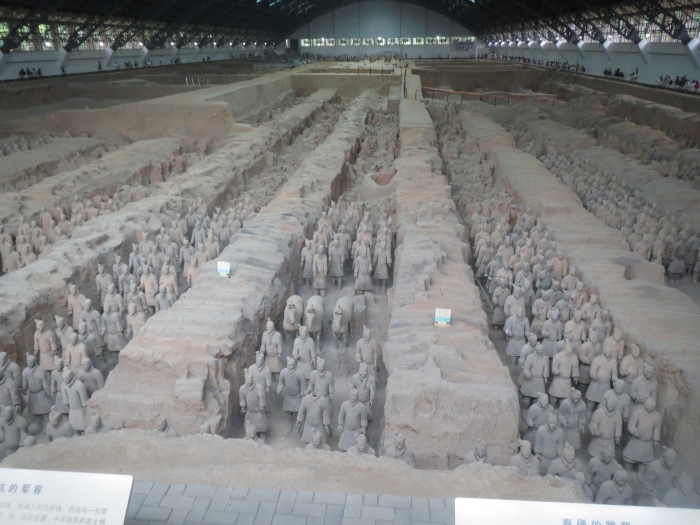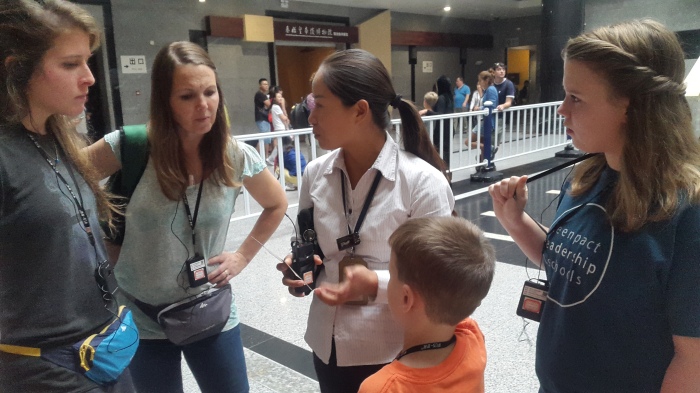
“This is amazing,” I thought to myself while looking over the oldest army in the world. It almost seemed surreal to me when I imagined that I could be standing in the same spot Qin Shi Huang, the First Emperor of China, stood around 2226 years ago to survey his army when it was vibrantly painted and ready to march off to battle. Qin Shi Huang built this army to fight for him in the afterlife and to protect his tomb from intruders, and though these clay warriors may have failed their original mission, many of them still stand strong thousands of years later as a testament to his name. And that is an accomplishment to be proud of.
On September 6th we rolled out of our comfortable hotel beds at 7:00 am (the softest beds we’ve slept in while here actually) and stopped down for breakfast before embarking on our adventure. This was our first breakfast that we have had away from home while in China and we were curious to see what would be on the menu. Luckily, we had a pleasant surprise. Eli was especially excited when he saw sugar cereal, his everyday breakfast in the States, on the buffet line. Though it still wasn’t quite waffles at the Holiday Inn (and I am still trying to figure out who would want to eat a cold vegetable salad for breakfast), we left the hotel with full bellies and were ready to seize the day.

Not many people take public transportation to the Terracotta warriors, but we decided to take the more adventurous (and cheaper) path and hopped onto the Xi’an city bus. After a short ride we transferred to a commuter bus which went out of the city and stopped at the Terracotta warriors. The only difficult part to this transition was that there were multiple buses who claimed to be this commuter bus, but only one was the real deal. We almost fell for one of these decoys when someone approached us wearing a uniform which looked exactly like the uniforms all of the city bus drivers wear. They lured us over to their bus, but just before getting on we came to the realization that this was one of those shifty buses our travel guide warned us about. Now I know I’m making it sound like we were about to be kidnapped, but I guess the circumstances weren’t actually that dire. The main reason you wouldn’t want to hop on one of these bad boys is that they are going to spike the rate sky high and dump you off on all their buddies’ souvenir shops on the way. Anyways, we eventually did select the correct bus. After a 45 minute bus ride, an increase in elevation, and a decrease in population we left the bus behind and made our way to the real attraction.

This picture was taken right after we ventured into the park. As we walked up to the ticket office a woman approached us and offered her services as tour guide. Because we saved on transportation we decided that this would be a good way to spend the money instead. She introduced herself as Jenny and then proceeded to help us get our tickets. Jenny also recommended that we rent ear pieces too so that we could hear her over the crowd. By the end of our visit we decided that this definitely was a worth investment as well!
The Warriors
On March 29, 1794 a farmer began to dig a well in search of precious water deep under the ground, but in the end he unearthed something much more valuable. Though only a head was unveiled on that fateful day, after years spent in excavation (which even continues today), the terracotta army was revealed to archaeologists in its full glory. The first emperor of unified China began to organize this massive project when he came to the throne at age 13. Now we can stand and observe three pits filled with warriors in the same manner the emperor may have so long ago.
Pit #1
Pit #1 is the largest of the three pits, and most likely the most well known. Most of the warriors in this pit have had the luck of surviving over 2000 years underground or with only minimal damage. Each warrior faces east to protect the emperor, excepting the warriors on the edges protecting the flank. It is interesting to look over the pit and notice the differences between each warrior. Each sculptor took the time to make his warrior like him, and this is evident from his uniform (which vary because of the part of China which the warrior came from) to his facial expression, and even age. The warriors are made slightly taller and larger than the average human and continued to get larger depending on their rank. Of course the emperor wouldn’t want a bunch of wimps defending his grave!


Pit #2
Pit #2 is relatively new, and not much is yet on exhibition. The main reason they have not dug into this pit is because the roof has mostly collapsed smashing most of the warriors. Each warrior takes about two years to put back together. Also they are looking into ways to keep maintain what color is left on the unearthed warriors. When the warriors were originally buried they were vibrantly painted and equipped with weaponry. It is evident by visible scorch marks and ash along the walls of the tunnels which have been excavated that the weapons were stolen when the army was still remembered.
Pit #3

Pit #3 is by far the smallest pit unearthed, but it was by far my favorite. What makes this pit special is the way the warriors are arranged. Archaeologists believe that this pit was arranged so differently because it was meant to represent a type of meeting room. The other side of the pit is also thought to represent a sacrifice room, as they have found bones and antlers along with the warriors.

Other artifacts were also found along with the warriors, such as a bronze chariot and tack. This is a picture of us near the end of the visit in the museum where these artifacts were displayed.
Once we had taken in this eighth wonder of the world to our fill, Jenny guided us to a place to eat. We then parted ways very thankful for the information she had given us. It was much more interesting with the small details, rather than just standing looking over a pit of clay dudes. After a meal of two-foot long noodles we wandered through the shops and eventually chose a few trinkets to take with us. We then slowly shuffled our way back to the bus station, pleased with ourselves and the adventure we had taken. It gives me a sense of satisfaction and thankfulness to know that I have seen something so wonderful that many people have gone their whole life without seeing and will never see and makes me wonder what other adventures still might be in store

-Audrey


Well written and interesting to hear about! Your reflection about realizing you’ve seen something that not everyone will experience in life can be said of your entire China experience. For all that this adventure has been – good, challenging, hard, frustrating, exciting, terrifying, etc. – you will be forever shaped by this. This experience will also influence every other adventure you face in life. I’m glad you are fully living in this moment and embracing the adventure of each new day!
LikeLike
You do an AMAZING job of sharing your wonderful experiences – some that we know we will never have. You are definitely seeing many historical sites when in China. Keep blogging . . . !
LikeLike
Great post Audrey! I look forward to reading about what adventures may lay ahead. Even granny is reading the blog.
LikeLike
I learned a lot reading this. Thank you for taking your readers along with you!
LikeLike
Hi Audrey. Thank you for taking us along on another great adventure. It is such fun keeping up with all of you as you experience new places. Keep up the great work, our little Pulitzer Prize winner. Love to all. We miss you.
LikeLike